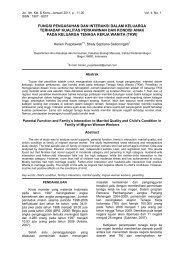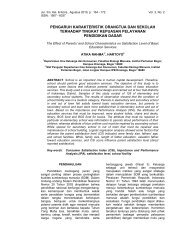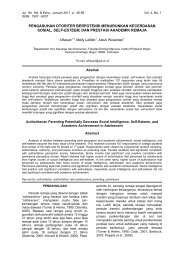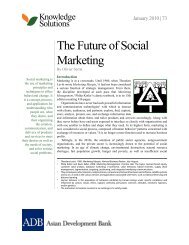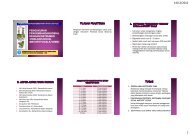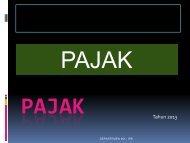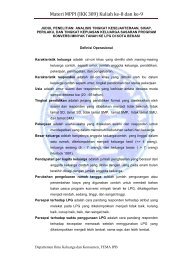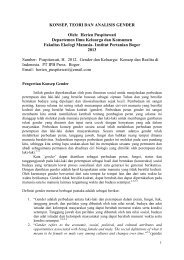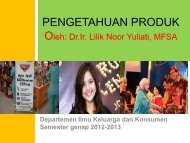Analysis of Poverty Profiles and Socioeconomic Determinants of ...
Analysis of Poverty Profiles and Socioeconomic Determinants of ...
Analysis of Poverty Profiles and Socioeconomic Determinants of ...
Create successful ePaper yourself
Turn your PDF publications into a flip-book with our unique Google optimized e-Paper software.
Current Research Journal <strong>of</strong> Social Sciences 3(1): 1-7, 2011ISSN: 2041-3246© Maxwell Scientific Organization, 2011Received: November 13, 2010 Accepted: December 13, 2010 Published: January 25, 2011<strong>Analysis</strong> <strong>of</strong> <strong>Poverty</strong> Pr<strong>of</strong>iles <strong>and</strong> <strong>Socioeconomic</strong> <strong>Determinants</strong> <strong>of</strong> Welfareamong Urban Households <strong>of</strong> Ekiti State, NigeriaD. Akerele <strong>and</strong> S.A. AdewuyiDepartment <strong>of</strong> Agricultural Economics <strong>and</strong> Farm Management, University <strong>of</strong> Agriculture,P.M.B. 2240, Abeokuta, Ogun State, NigeriaAbstract: The study focused on assessment <strong>of</strong> household poverty <strong>and</strong> welfare among households in Ekiti State,Nigeria. Using a multistage sampling approach, a total <strong>of</strong> 80 households were selected <strong>and</strong> interviewed withthe aid <strong>of</strong> well structured questionnaire. Data collected were subjected to analyses such as descriptive statistics,poverty index <strong>and</strong> multiple regression analysis. The result revealed the 38.30 percent <strong>of</strong> the households coveredby the study were poor <strong>and</strong> would have to mobilize financial resources up to 41.80% <strong>of</strong> 1 US Dollar (N130)per day (for each household member) to be able to escape poverty. Female headed households in the study areaappear to be more vulnerable to income poverty with poverty incidence, depth <strong>and</strong> severity <strong>of</strong> values 0.221 <strong>and</strong>0.239, 0.402 <strong>and</strong> 0.191, respectively. Highest levels <strong>of</strong> poverty were found among household with 7-9dependants with values 1.00, 0.715 <strong>and</strong> 0.511 for the incidence, depth <strong>and</strong> severity <strong>of</strong> poverty respectively.Educational levels <strong>of</strong> household head <strong>and</strong> spouse, gender <strong>of</strong> household head <strong>and</strong> dependency ratio are factorsthat exact significance influence on household welfare. In order to reduce poverty <strong>and</strong> promote peoples’welfare, policies that would promote employment opportunities; educational status <strong>of</strong> household head, spouse<strong>and</strong> household members as well as efforts to enhance women access to more productive resources <strong>and</strong>investment in infrastructural development are recommended.Key words: Ekiti State, households, Nigeria, poverty index, poverty pr<strong>of</strong>iles, welfareINTRODUCTION<strong>Poverty</strong> is one <strong>of</strong> the most serious manifestations <strong>of</strong>human deprivation <strong>and</strong> is inextricably linked to humancapital development; it is thus an issue <strong>of</strong> global concern.<strong>Poverty</strong> is a plague afflicting people all over the world<strong>and</strong> it is considered one <strong>of</strong> the symptoms or manifestation<strong>of</strong> underdevelopment. <strong>Poverty</strong> encompasses inadequateincome <strong>and</strong> denial <strong>of</strong> the basic necessities such aseducation, health services, clean water <strong>and</strong> sanitation(World Bank, 2007) which are essential for humansurvival <strong>and</strong> dignity. Onibokun <strong>and</strong> Kumuyi (1996) intheir study on urban poverty argue that poverty is linkedto a shortage <strong>of</strong> vital resources <strong>and</strong> the endurance <strong>of</strong> harsh<strong>and</strong> inhospitable environment, including the breakdown<strong>of</strong> economics, demographic, ecological, cultural <strong>and</strong>social systems. Gass <strong>and</strong> Adetunmbi (2000) asserted thatpoverty denies its victims the most basic needs forsurvival, such as food, water, clothing <strong>and</strong> shelter.<strong>Poverty</strong> manifests itself not only in economic deprivationbut also in terms <strong>of</strong> an individual’s inability to accessbasic social amenities (CBN/World Bank, 1999). Aconcluding definition recognizes poverty as a way <strong>of</strong> livecharacterized by low calorie intake, inaccessibility toadequate health facilities low quality education system,low income, unemployment, <strong>and</strong> under employment <strong>and</strong>inaccessibility to various housing <strong>and</strong> societal facilities(Onibokun <strong>and</strong> Kumuyi, 1996).No developing country can afford to ignore thephenomenon <strong>of</strong> urbanization, which will be one <strong>of</strong> thestrongest social forces in coming years, especially indeveloping countries. Urban population in the developingcountries is growing faster than that <strong>of</strong> the ruralpopulation. This has been attributed among others, torural-urban migration <strong>and</strong> the rapid transformation <strong>of</strong>rural areas to urban places. There is the possibility thaturban population growth rate will increase by almosttwice that <strong>of</strong> the world’s population growth rate between2003 <strong>and</strong> 2030 (United Nations, 2004). According toRuel et al. (1998), data from eight countries containingapproximately two-thirds <strong>of</strong> the developing world’speople suggest that the locus <strong>of</strong> poverty is shifting fromrural areas to urban areas. The data show that in seven(Nigeria inclusive) out <strong>of</strong> the eight countries, the share <strong>of</strong>the poor people in urban areas is increasing. In Nigeria,the incidence <strong>of</strong> poverty has been on the increase. It rosefrom 28.1% in 1980 to 46.3% in 1985 <strong>and</strong> to 65.6% in1996 (National Bureau Statistic (NBS), 2006). Eventhough it fell to 54.4% in 2004, the population <strong>of</strong>Nigerians living in poverty has been on the increase. Itrose from 18.26 m in 1980 to 34.37 m in 1985 to 67.11 min 1996 <strong>and</strong> was put at 68.70 in 2004 (NBS, 2006) withCorresponding Author: D. Akerele, Department <strong>of</strong> Agricultural <strong>and</strong> Food Economics, University <strong>of</strong> Reading, School <strong>of</strong>Agriculture, Policy <strong>and</strong> Development, P.O. Box 237, Reading, RG6 6AR, United Kingdom1
Curr. Res. J. Soc. Sci., 3(1): 1-7, 2011the number <strong>of</strong> urban poor in the increase over time(Ruel et al., 1998).Furthermore, poverty gap in Nigeria is widening <strong>and</strong>a greater proportion <strong>of</strong> the nation’s wealth is beingconcentrated in the h<strong>and</strong>s <strong>of</strong> the wealthiest 20% <strong>of</strong> thenation (Ali-Akpajiak <strong>and</strong> Pyke, 2003). This widen gap <strong>of</strong>inequality further marginalizes the poor <strong>and</strong> has been one<strong>of</strong> the reasons agitation for salary increment <strong>and</strong> mayserve as a breeding ground for civil strife <strong>and</strong> politicalinstability. These issues <strong>of</strong> inequality <strong>and</strong> poverty in thecities have necessitated governments <strong>and</strong> internationalagencies whose programmes have traditionallyconcentrated on rural areas to move (systematically) todevelop strategies to improve urban livelihoods. Acursory examination <strong>of</strong> the poverty situation vis-à-vis thesocio-demographic characteristics <strong>of</strong> households willprovide inside to some basic underlining factors (partways) to widened income gap <strong>and</strong> poverty in acommunity. This will provide guides for formulatingpolicies <strong>and</strong> interventions that will help alleviate povertyin the area. The above <strong>and</strong> other factors, which mighthave contributed to the problem <strong>of</strong> poverty in the studyarea, were the main issues that prompted this study. Thestudy therefore seeks to assess the poverty levels <strong>and</strong> thesocioeconomic determinants <strong>of</strong> household welfare EkitiState, Nigeria, with the view to providingrecommendations for policy formulation that could helpreduce poverty <strong>and</strong> improve the living conditions <strong>of</strong> thepeople in the study area. Specifically, the study seeks toprovide answer to the following questions: Arehouseholds in the study area poor? What is the extent <strong>of</strong>poverty <strong>and</strong> how is poverty distributed among households<strong>of</strong> different socioeconomic status? What factors influencethe welfare <strong>of</strong> households? What are the policyimplications <strong>of</strong> this study?Method <strong>of</strong> data collection: Data was sourced from twomain sources - primary data through personal interviewswith the aid <strong>of</strong> structured questionnaire, which was themajor source <strong>of</strong> data <strong>of</strong> for the study <strong>and</strong> secondary datafrom journals, books, <strong>and</strong> other sources.Sampling procedure: Multistage sampling technique wasemployed to select eighty households in the study area.The first stage was the r<strong>and</strong>om selection <strong>of</strong> five politicalwards from the thirteen wards in the study area. Thesecond stage featured another simple r<strong>and</strong>om selection <strong>of</strong>two streets from each political ward. This made up a totalnumber <strong>of</strong> ten streets. The third stage involved asystematic r<strong>and</strong>om sampling <strong>of</strong> eight houses from eachstreet; making a total <strong>of</strong> eighty houses. The last stage wasthe purposive selection <strong>of</strong> one household (each) from each<strong>of</strong> the houses, making a total <strong>of</strong> eighty households.Questionnaire was administered mainly to households’heads, but other household members were allowed toprovide relevant information which could not beadequately supplied by the households’ heads.<strong>Poverty</strong> assessment: This was determined by adoptingthe FGT poverty index developed by Foster et al. (1984),which has found wider application in scholarly works(Appleton, 1996; Ayinde et al., 2002). The model is aclass <strong>of</strong> additively decomposable measure <strong>of</strong> poverty.The measure subsumes the headcount index <strong>and</strong> thepoverty gap, <strong>and</strong> provides the distributional sensitivemeasure through the choice <strong>of</strong> a poverty aversionparameter “”; the larger the value <strong>of</strong> the “”, the greaterthe weight given by the index to the severity <strong>of</strong> poverty(Anyawu, 1997).The general specification <strong>of</strong> the model is givenbelow:MATERIALS AND METHODSStudy area: The study area is Ado- Ekiti, the capital <strong>of</strong>Ekiti State, Nigeria, between January <strong>and</strong> March, 2008.The study area lies between latitude 7º15 <strong>and</strong> 8º07 North<strong>of</strong> the equator <strong>and</strong> longitude 4º47 <strong>and</strong> 5º45 East <strong>of</strong> theGreenwich meridian. It has a mean annual temperature <strong>of</strong>about 27ºC, <strong>and</strong> a mean annual rainfall <strong>of</strong> about 1400 mmwith vegetation mainly rainforest. The soil is largely richin organic minerals thereby making the study area a majorproducer <strong>of</strong> food crops such as rice, cassava, yam, <strong>and</strong>maize (EKCPRA, 2002). Ado-Ekiti is made uppredominantly <strong>of</strong> the Yoruba ethnic group with a fewother ethnic groups. The indigenous populations are moreor less homogenous groups who speak same languagewith minor dialects differences. There are other tribes thatco-exist with each other. The dwellers in the study areaare mainly civil servants as well as those with privateestablishments who are also engaged in agriculture fortheir living.where; y* i =y iif y i< z <strong>and</strong> y* i= Z if y i ZP = Foster Greer <strong>and</strong> Thorbecke index (0 P 1)N = Total number <strong>of</strong> the sampled households underconsiderationz = <strong>Poverty</strong> Line (1 US Dollar per day (x130))y i= Daily per capita expenditure <strong>of</strong> ith household. = FGT parameter (µ 0)i = individual household(1)The takes on a value <strong>of</strong> 0, 1, 2, with differentimplications:When = 0, it measures poverty incidence. Thistranslates to the headcount ratio (Anyawu, 1997), that isthe proportion <strong>of</strong> the households below poverty level.2
Curr. Res. J. Soc. Sci., 3(1): 1-7, 2011When = 1, it measures the depth <strong>of</strong> poverty or povertygap; that is the proportion <strong>of</strong> the poverty threshold (line)that an average poor household will require to at attain tothe poverty line. When = 2, it measures the severity <strong>of</strong>poverty; that is how serious poverty is. It gives moreweight to the poorest. The closer the value is to 1, thehigher the seriousness <strong>of</strong> poverty. For this study, thewidely used 1US dollar (x130) per day was used as thepoverty line. Consequently, a household is considered tobe poor if the household’s per capita expenditure per dayis lower than the poverty line <strong>of</strong> 1US dollar (x 130) perday as at the time <strong>of</strong> data collection.Welfare model: The Ordinary Least Square MultipleRegression was employed to analysis the various socioeconomicfactors influencing household welfare in thestudy area. Empirical studies have shown that householdper capital expenditure can provide insight into economicwelfare or the living condition <strong>of</strong> household’s especiallyin the situation where the major proportion <strong>of</strong> householdincome comes from the informal sector. Scholars such asPMS (2001), Okojie (2002) <strong>and</strong> Benson <strong>and</strong> Mukherjee(2003) have modeled the determinant <strong>of</strong> householdwelfare by using the per capita householdexpenditure/consumption as dependent variable <strong>and</strong> otherhousehold characteristics <strong>and</strong>/or community factors as theindependent variables. The welfare model is as specified:LnY = a + b 1X 1+ b 2X 2+ b 3X 3+ b 4X 4+ b 5X 5+ b 6X 6+ e (2)Y = Household per capita expenditure (Naira)X 1= Educational status <strong>of</strong> household head (years)X 2= Educational status <strong>of</strong> household head (years)X 3= Household head age (years)X 4= Gender <strong>of</strong> household head (1 = female, 0 = male)X 5= Remittance dummy (1 = if household received 0 =otherwise)X 5= Household head’s major occupation (1=salary/wage earner, 0 = non-salary earner)X 6= Dependency ratio (the ratio <strong>of</strong> those that are notgainfully employed (i.e., not earning income) tothose that are gainfully employed (earning income)within the householde = Error termRESULTS AND DISCUSSIONLiving status <strong>of</strong> households in Ado-Ekiti, Ekiti state:The housing conditions <strong>of</strong> a household provide goodindicators <strong>of</strong> welfare measurement. The result (Table 1)shows that majority (43.75%) <strong>of</strong> the respondenthouseholds in study area lived in flat. As much as 30.00%lived in single room; about 25.00% <strong>of</strong> the respondenthousehold lived in whole building <strong>and</strong> the remainingTable 1:Distribution <strong>of</strong> Households by housing type, floor materials,tenure <strong>of</strong> housing unit <strong>and</strong> monthly rent on housing unit inAdo-EkitiInformation Frequency %Housing unit type Single room 24 30.00 Flats 35 43.75 Whole building 20 25.00 Duplex 1 1.25Floor materials Tile 4 5.00 Concrete 72 90.00 Terrazzo 4 5.00Tenure <strong>of</strong> housing unit Normal rent 56 70.00 Free 3 3.75 Owner occupier 21 26.25Monthly rent (x) for housing unit 501 - 1000 35 43.75 1001- 1500 3 3.75 1501- 2000 10 12.50 2001- 2500 17 21.25 2501 <strong>and</strong> above 15 18.75Mean 1733.20Field Survey Data (2008)1.25% <strong>of</strong> the sampled households lived in duplex.Majority (90.00%) <strong>of</strong> the respondents lived in concretefloor housing unit. About 5.00% <strong>of</strong> the respondents livedin tile floor housing unit, while the remaining respondents(5.00%) lived in housing unit with terrazzo as floormaterials. Majority (70.00%) <strong>of</strong> the household paidnormal rent for the housing unit, while about 26.25% <strong>of</strong>the respondents’ households owned their houses while3.75% paid no rent for housing unit. This is an indication<strong>of</strong> differences in urban pattern <strong>of</strong> living conditions amonghouseholds in the study area. Most (43.75%) <strong>of</strong> thehouseholds paid between x 501 <strong>and</strong> N1000 per month onhousing unit with the mean monthly rent being N 1733.20as at the time <strong>of</strong> data collection.Description <strong>of</strong> households by major source <strong>of</strong> waterfor drinking <strong>and</strong> cooking, sanitary conditions <strong>and</strong>sources <strong>of</strong> electricity supply: Information on the sources<strong>of</strong> water for drinking <strong>and</strong> cooking, sanitary conditions aswell as supply <strong>of</strong> electricity could provide insight to theliving conditions <strong>of</strong> people. As noted by Maziya-Dixon et al. (2004), availability <strong>of</strong> infrastructure suchelectricity <strong>and</strong> pipe borne water are closely linked withfood security as well as poverty. The result in Table 2shows that the most common source <strong>of</strong> water available tohouseholds was well (protected) which accounted for55.50%. Next to this source was pipe borne water whichaccounted for 20.00%. The use <strong>of</strong> bore holes (whichaccounted for 15.0%) are becoming increasingly popularin the study area. About 5.0 percent subscribed totankers/truck while 7.50% <strong>of</strong> the household respondentmade use <strong>of</strong> well (unprotected). This finding is compareswith the survey <strong>of</strong> nation on major source <strong>of</strong> water in2005, which found that the major source <strong>of</strong> water3
Curr. Res. J. Soc. Sci., 3(1): 1-7, 2011Table 2: Distribution <strong>of</strong> household by major source <strong>of</strong> water fordrinking <strong>and</strong> cooking, sanitary conditions <strong>and</strong> sources <strong>of</strong>electricity supplyInformation Frequency %Source <strong>of</strong> water Pipe borne water 16 20.00 Well protected 42 52.50 Borehole 12 15.00 Tanker/truck 4 5.00 Well unprotected 6 7.50Source <strong>of</strong> electricity None 6 7.50 PHCN only 44 55.00 PHCN <strong>and</strong> electric generator 28 35.00 Generator only 2 2.50Type <strong>of</strong> refuse disposal commonly used Household bins collected 18 22.50by government agency House bin collected by private agency 1 1.25 Unauthorized refuse heap 37 46.25 Others unauthorized place 24 30.00Toilet facilities Covered pit 38 47.50 Uncovered pit 5 6.20 Water closet 35 43.80 Bush 2 2.50Field Survey (2008)available to Nigerians is well (NBS, 2006). Majority(55.0%) <strong>of</strong> the households used Power Holding Company<strong>of</strong> Nigeria (PHCN) electricity only. About 35.00% <strong>of</strong> therespondent use PHCN complimented with complimentedwith generators. About 7.50% <strong>of</strong> the household do nothave any source <strong>of</strong> electricity supply as at the time <strong>of</strong> datacollection while 2.50% <strong>of</strong> the households used privategenerator only. This use <strong>of</strong> generators which is nowincreasingly populous may be due to the erratic powersupply situation in the country; a situation which hasnecessitated some households to look for other alternativemeans <strong>of</strong> generating electricity such as electric generators<strong>and</strong> inverters. The results further indicates that majority(46.25%) <strong>of</strong> the household disposed their refuse in anunauthorized refuse heap. In addition, 22.50% <strong>of</strong> thehousehold made use <strong>of</strong> household bins which are <strong>of</strong>tencollected by government agency while about 30.00% <strong>of</strong>the household made use <strong>of</strong> combinations <strong>of</strong> the dumpingrefuse in bushes or burning within their compounds whilethe remaining 1.25% <strong>of</strong> the households made used <strong>of</strong>household bins collected by private agency. In terms <strong>of</strong>toilet facilities, the result indicates that the mostcommonly used toilet facility is the pit latrines whichaccounted for about 47.50%. Water closet toilet accountedfor 43.80%; the next was the use <strong>of</strong> uncovered pit toiletswhich accounted for 6.20% in the study area while 2.50%<strong>of</strong> the households made use <strong>of</strong> the bush.The levels <strong>of</strong> poverty among households in the studyarea: The result <strong>of</strong> the poverty pr<strong>of</strong>ile among householdsby socio-demographic characteristics in the study area ispresented in Table 3. On the aggregate, the head countTable 3: <strong>Poverty</strong> pr<strong>of</strong>ile among households by demographiccharacteristics<strong>Poverty</strong> <strong>Poverty</strong> SeveritySocio-demographic incidence intensity <strong>of</strong> povertycharacteristics (P 0) (gap) (P 1) (P 2)Household size1-3 0.274 0.338 0.1374-6 0.315 0.497 0.2917-9 0.515 0.837 0.716Dependency ratioNo dependant 0.005 0.167 0.0511-3 0.191 0.251 0.0914-6 0.693 0.650 0.4887-9 1.000 0.715 0.511Educational level <strong>of</strong> household headPrimary 0.301 0.231 0.053Secondary 0.412 0.535 0.314Tertiary 0.092 0.098 0.011Gender <strong>of</strong> household headMale 0.221 0.379 0.181Female 0.239 0.402 0.191Major occupation <strong>of</strong> household headSalary/wage earners 0.286 0.383 0.257Non salary/wage earners 0.149 0.389 0.180Household asset quartileFirst 0.800 0.444 0.223Second 0.550 0.402 0.195Third 0.350 0.390 0.178Fourth 0.300 0.346 0.133Whole household 0.383 0.418 0.234Field Survey Data (2008)ratio is 0.383. This means that 38.30% <strong>of</strong> the householdscovered by the by the study in Ado-Ekiti area are poor,while 23.40% <strong>of</strong> the households are core poor.Concerning the poverty depth or gap, an average poorhousehold would have to mobilize financial resources upto 41.80% <strong>of</strong> 1 US Dollar (x 130) per day (for eachhousehold member) to be able to escape poverty. Onecould therefore infer from this finding that evidences <strong>of</strong>poverty abounds among households in Ado Ekiti, henceadequate measures must be put in place in order tosalvage the present situation <strong>and</strong> also to forestall a worsensituation in the future. The study also reveals that increasein household size results in increase poverty situationamong households in the study area with the incidence,depth <strong>and</strong> severity highest with values 0.515, 0.837 <strong>and</strong>0.716, respectively for household with 7 to 10 members.The situation might be worse still if the increase inhousehold size translates into more dependants who donot contribute to the household income as the measures <strong>of</strong>poverty are also very higher among household with highernumber <strong>of</strong> dependants having values 1.00, 0.715 <strong>and</strong>0.511, respectively for the incidence, depth <strong>and</strong> severity<strong>of</strong> poverty. Ability to <strong>of</strong> household members to work <strong>and</strong>earn income is critical to poverty reduction in the studyarea.A close look at the educational level <strong>of</strong> householdheads reveals that poverty reduces with improvededucational level <strong>of</strong> household head. Although it appearsthat incidence <strong>of</strong> poverty is higher among households4
Curr. Res. J. Soc. Sci., 3(1): 1-7, 2011whose head had secondary school education, this does notdownplay the importance <strong>of</strong> education in povertyreduction. Evidence abounds on the positive impact <strong>of</strong>education on poverty reduction. It could be that thesehouseholds harbour larger household size with moredependants who do not contribute to household income.Access to education does result in increase in the stock <strong>of</strong>human capital, <strong>and</strong> in turn labour productivity <strong>and</strong> wageswhich in turn results in reduction <strong>of</strong> poverty in thehouseholds. The role <strong>of</strong> capacity building <strong>and</strong> humancapital development in eradicating poverty cannot be overemphasis. Education equips the people with information<strong>and</strong> new technologies that are necessary for enhancingeconomic activities (Ruel et al., 1998; Oniang’o <strong>and</strong>Makudi, 2002). Policy that would ensure sustained <strong>and</strong>improved access to education will go along way to reducepoverty in the study area.The result also reveals that incidence, depth <strong>and</strong>severity <strong>of</strong> poverty appear higher with values 0.29, 0.402<strong>and</strong> 0.191 in female headed households than in maleheaded households. This means than female headedhouseholds are more vulnerable to poverty than the maleheaded households. Female-headed households are <strong>of</strong>tenconsidered to be more vulnerable to poverty because <strong>of</strong>their tighter time schedule <strong>and</strong> income constraints thanmale headed households. Their vulnerability may partlybe as a result <strong>of</strong> lack <strong>of</strong> access to or low productiveresources, education, credit, <strong>and</strong> decision making forums(Oniang’o <strong>and</strong> Makudi, 2002). In line with the increasingimportance given to gender issues, many governments inthe world have established institutions to promotewomen’s interest in at least one <strong>of</strong> their ministries.However, these issues are <strong>of</strong>ten still tackled from welfareside, <strong>and</strong> in practice, women are still far from the mainstream <strong>of</strong> development efforts (African DevelopmentForum, 2008). This disclosure is sine qua non to theglobal phenomenon <strong>of</strong> feminization <strong>of</strong> poverty.The severity <strong>of</strong> poverty is higher among householdsheaded by salary earners than non salary/wage earners. Itmight be completely misleading to absolutely agree thathouseholds headed by salary/wage earners in the studyarea are more vulnerable to poverty. According to(Haan, 2000), access to well-paying steady or secure jobsis germane to reducing poverty <strong>and</strong> food insecurity. Onthe other h<strong>and</strong>, Ruel et al. (1998) submitted that urbanlow income (salary/wages) earners or salary/wageworkers with no other source <strong>of</strong> income are <strong>of</strong>tenvulnerable to poverty. Haan (2000) added that holding totoo long to low paying <strong>and</strong> unstable jobs put a householdat high risk <strong>of</strong> poverty <strong>and</strong> food insecurity. The tendency<strong>of</strong> households headed by non-salary/wage earners in thestudy area to be less severely affected by poverty mightbe that these household heads derive income from diverseincome sources. Diversification as a source <strong>of</strong> incomegrowth is a potential means <strong>of</strong> poverty reductionTable 4: Result <strong>of</strong> household welfare modelVariable Coefficient t-values ProbabilityConstant 8.905*** 8.996 0.000Educational level <strong>of</strong> 0.068* 1.719 0.090household headEducational level <strong>of</strong> spouse 0.161* 1.731 0.087Age <strong>of</strong> household head - 0.002 - 0.238 0.813Sex <strong>of</strong> household head 0.141*** 5.537 0.000Remittance dummy - 0.355 - 1.035 0.304Occupational dummy 0.363 1.143 0.257Dependency ratio - 0.197** - 2.080 0.041R-Square 0.684F-value 12.323*** 0.000Computed from Field Survey Data (2008)***: Significant at 1% -level; **: Significant at 5% -level; *:Significant at 10% -level(Nicholas et al., 2006). The result also shows that povertyalso reduces with increased level <strong>of</strong> household assets;emphasizing the important role productive assets inincome generation <strong>and</strong> poverty.Welfare function estimation: The result <strong>of</strong> the estimatedwelfare model is presented in Table 4. The coefficient <strong>of</strong>multiple determination (R 2 ) with value 0.684 implies that63.7% <strong>of</strong> the total variation in the household expenditureper capita is accounted for by all the explanatory variablesin the regression model. The significance <strong>of</strong> the F-value(12.323) implies that all the explanatory variable jointlyexact significant influence on household welfare (as proxyby household expenditure per capita). Out <strong>of</strong> the sevenexplanatory variables used in the regression model, onlyfour were significant. They are sex <strong>of</strong> household head,educational level <strong>of</strong> household head, household size <strong>and</strong>dependency ratio. The result shows that there is a positive<strong>and</strong> significant relationship between the gender <strong>of</strong>household head <strong>and</strong> economic welfare <strong>of</strong> the householdwhich suggests that an average household headed by maleseems better in terms <strong>of</strong> their economic welfare or livingconditions than female headed household in the studyarea. Empirical studies in Nigeria indicates men are havemore access to formal education <strong>and</strong> other productiveresources in Nigeria than their women counterpart(although great deal <strong>of</strong> efforts are now been made to closethe gap). This disparity, among others, is the reason forbetter economic advantage being enjoyed by men in thecountry. Ability to work, become more productive, earnhigher income <strong>and</strong> improve the st<strong>and</strong>ard <strong>of</strong> living <strong>of</strong>household members is contingent on access to productiveresources. Limited access to these resources has however,constrained women to remain for long on low-paying jobs<strong>and</strong> especially in the informal sector with its attendantnegative implication on their welfare <strong>and</strong> the householdsheaded by them.Educational level <strong>of</strong> household head <strong>and</strong> that <strong>of</strong>spouse both have positive influence effect on householdwelfare (measured by household per capita expenditure).This implies that an additional year gained by the5
Curr. Res. J. Soc. Sci., 3(1): 1-7, 2011household head <strong>and</strong> spouse in acquiring formal educationwould lead to rise in household income <strong>and</strong> byimplication, the welfare <strong>of</strong> household members.Educational attainment enhances human capital <strong>and</strong>participation in labour market <strong>and</strong> has been widelyaccepted as a veritable tool for poverty reduction <strong>and</strong>improving peoples’ welfare. The coefficients 0.068 <strong>and</strong>0.161 <strong>of</strong> household head <strong>and</strong> spouse suggest that anadditional year in their education level is expected toresult in 6.8 <strong>and</strong> 16.1% increase in household per capitaexpenditure. Dependency ratio exacts a negative impact<strong>of</strong> household welfare, suggesting that increasesdependency ratio (an increase in household size whichtranslates to increases in the number <strong>of</strong> dependants)would result in reduction in the income resourcesavailable to cater for the needs <strong>of</strong> each householdmember. The decline in the per capita income (resource)availability is an indication <strong>of</strong> down spiral livingconditions <strong>of</strong> household members. The coefficient -0.197<strong>of</strong> dependency ratio implies that a unit increase in thedependency ratio will lead to 19.7% decrease in thehousehold consumption per capita. This scenario alsoposes a serious threat on the welfare <strong>of</strong> members <strong>of</strong>households in the study area, especially among the lowincomepoor groups.CONCLUSION AND RECOMMENDATIONThe ramifying objective <strong>of</strong> the study was to examinethe poverty status <strong>of</strong> household by demographiccharacteristics in Ado-Ekiti, Ekiti State. The studyestablishes evidence <strong>of</strong> poverty <strong>and</strong> decline livingconditions in the study area. The incidence, depth <strong>and</strong>severity <strong>of</strong> poverty are high <strong>and</strong> burden <strong>of</strong> poverty isborne disproportionately by households <strong>of</strong> differentsocioeconomic status. <strong>Poverty</strong> appears to be feminized asall measures <strong>of</strong> poverty are consistently higher forhouseholds headed by females in the study area.Households with larger size (members), more dependants<strong>and</strong> with limited assets are more susceptible to poverty<strong>and</strong> down spiral welfare conditions. Improved educationallevel <strong>of</strong> household head <strong>and</strong> spouse as well as lower level<strong>of</strong> dependency ratio would help reduce poverty <strong>and</strong>enhance household welfare in the study area.The implication <strong>of</strong> the findings is that efforts toinvestment in education <strong>of</strong> household head, spouse as wellas that <strong>of</strong> household members; enhance women status <strong>and</strong>reduce the dependency ratio are crucial for povertyreduction in the study area. The study therefore,recommends among others, improvement in enhancement<strong>of</strong> human capital though investment in formal education.This should involve training in life skills <strong>and</strong> vocationswhich would help stimulate the innate entrepreneurialpotentials <strong>of</strong> the people <strong>and</strong> exp<strong>and</strong> the frontier <strong>of</strong> theirincome generating capacities <strong>and</strong> become moreproductive. Furthermore, policy efforts that wouldfacilitate employment opportunities would help reduce thenumber <strong>of</strong> dependants (who could be potentiallyemployed) <strong>and</strong> enable them to contribute to the generalhousehold welfare. Gender policy measure to that wouldfocus on building women capacity <strong>and</strong> skew moreresources productive resources towards them would bel<strong>and</strong> mark achievement in reducing poverty <strong>and</strong>promoting household welfare. Efforts by bothgovernments <strong>and</strong> non governmental agencies in the area<strong>of</strong> infrastructural development (provision electricitysupply, boreholes, pipe borne water, among others) wouldgo a long way to improve the living condition <strong>of</strong> peoplein the study area.REFERENCESAfrican Development Forum, 2008. Action On GenderEquality, Women’s Empowerment <strong>and</strong> EndingViolence Against Women in Africa. EmpoweringAfrican Women, Issues Paper 2. The sixth AfricanDevelopment Forum (ADF VI) United NationsConference Centre - Addis Ababa, Ethiopia African,19-21 November 2008. Retrieved from:http://www.uneca.org/adfvi/documents/ADFVI_IssuesPaper2_ENG.pdf, (Accessed on: December 06,2010).Ali-Akpajiak, S.C.A. <strong>and</strong> T. Pyke, 2003. Measuringpoverty in Nigeria. Oxfam Working Paper, OxfamGB, 274, Oxford.Anyawu, J.D., 1997. <strong>Poverty</strong> in Nigeria: Concepts,Measurements <strong>and</strong> <strong>Determinants</strong>. In: Obaseki, P.J.(Eds.), <strong>Poverty</strong> Alleviation in Nigeria. Proceedings <strong>of</strong>Nigeria Economic Society Annual Conference.Appleton, S., 1996. Women-headed households <strong>and</strong>household welfare: An empirical deconstruction forUg<strong>and</strong>a. World Dev., 24(12): 1811-1827.Ayinde, I.A., C.A. Afolami, A.B. Aromolaran,I.O. Vaughan <strong>and</strong> A.O. Fanimo, 2002. Intra-zonalpoverty situation among farmers in Ogun State,Nigeria. Moor J. Agric. Res., 3(2): 306-312.Benson, T. <strong>and</strong> S. Mukherjee, 2003. The determinants <strong>of</strong>poverty in Malawi, 1998. World Dev., 31(2):339-358.Central Bank <strong>of</strong> Nigeria/World Bank, 1999. Nigeria’sDevelopment Prospects: <strong>Poverty</strong> Assessment <strong>and</strong>Alleviation Study, 8 March 1999.EKCPRA, 2002. Ekiti State Community - Based povertyreduction agency monthly/quarterly report. Firstquarter’s report.Foster, J., J. Greer <strong>and</strong> E. Thorbecke, 1984. A class <strong>of</strong>decomposable poverty measures. Econometrica,52(3): 761-766.Gass, G. <strong>and</strong> O. Adetunmbi, 2000. Summary report:DFID’s civil society consultation.6
Curr. Res. J. Soc. Sci., 3(1): 1-7, 2011Haan, A.D., 2000. Achieving Urban Food <strong>and</strong> NutritionSecurity in the Developing World: Urban Livelihood<strong>and</strong> Labour Markets. Focus. 3. Brief 4 <strong>of</strong> 10, IFPRI.Retrieved from: http://www.ifpri.org/sites/default/files/publications/focus03_04.pdf, (Accessed on:December 06, 2010).Maziya-Dixon, B.M., I.O. Akinyele, E.B. Oguntona,S. Nokoe, R.A. Sanusi <strong>and</strong> E. Harris, 2004. Nigeriafood consumption <strong>and</strong> nutrition survey 2001- 2003Summary, International Institute <strong>of</strong> TropicalAgriculture (IITA).National Bureau <strong>of</strong> Statistics (NBS), 2006. <strong>Poverty</strong>pr<strong>of</strong>ile for Nigeria. Ganfeek, Ventures, pp: 87.Nicholas, M., B. Baulch <strong>and</strong> M. Epprecht, 2006. <strong>Poverty</strong><strong>and</strong> inequality in Vietnam: Spatial patterns <strong>and</strong>geographic determinants. IFPRI Research report 148.Okojie, C.E., 2002. Gender <strong>and</strong> education as determinants<strong>of</strong> household poverty in Nigeria. United NationsUniversity, World Institute fir development economicresearch, Discussion Paper No. 2002/37.Oniang’o, R. <strong>and</strong> E. Mukudi, 2002. Nutrition <strong>and</strong> Gender:A Foundation for Development. Brief 7 <strong>of</strong> 12, UNACC/SCN, Geneva.Onibokun, A. <strong>and</strong> A. Kumuyi, 1996. Urban poverty inNigeria: Towards sustainable strategiesfor itsalleviation. Centre for African Settlement Studies <strong>and</strong>Development (CASSAD) Ibadan, Nigeria.<strong>Poverty</strong> Monitoring System (PMS), 2001. The<strong>Determinants</strong> <strong>of</strong> <strong>Poverty</strong> in Malawi: Which EffortsWill Reduce <strong>Poverty</strong> in Malawi the most? The<strong>Poverty</strong> <strong>Analysis</strong> <strong>of</strong> Integrated the HouseholdSurvey, PMS policy brief No. 8, June 2001.Retrieved from: http://www.nso.malawi.net/data_on_line/ economics/ihs/poverty_brief_determinants.pdf,(Accessed on: December 06, 2010).Ruel, M.T., J.L. Garratt, S.S. Morris, D. Maxwell,A. Oshaug, P. Engle, P. Menon, A. Slack <strong>and</strong>L. Haddad, 1998. Urban challenges to foods <strong>and</strong>nutrition security: A review <strong>of</strong> food security health<strong>and</strong> care giving in cities. FCND Discussion paper no.51. IFPRI.United Nations, 2004. Report <strong>of</strong> the Secretary-General onthe Review <strong>and</strong> Appraisal <strong>of</strong> the Progress Made inAchieving the Goals <strong>and</strong> Objectives <strong>of</strong> theProgramme <strong>of</strong> Action <strong>of</strong> the International Conferenceon Population <strong>and</strong> Development, 2004. PopulationNewsletters Number 77. Population Division <strong>of</strong> theUnited Nations Secretariat, Department <strong>of</strong> Economic<strong>and</strong> Social Affairs New York. Retrieved from: http://www.un.org/esa/population/publications/popnews/Newsltr_No.%2077.pdf, (Accessed on: December 06,2010).World Bank, 2007. <strong>Poverty</strong> at a glance, World Bank IssueBrief/<strong>Poverty</strong>. Retrieved from: http://siteresources.worldbank.org/INTPOVERTY/Resources/<strong>Poverty</strong>Brief_Sep2007.pdf, (Accessed on: December 06,2010).7



